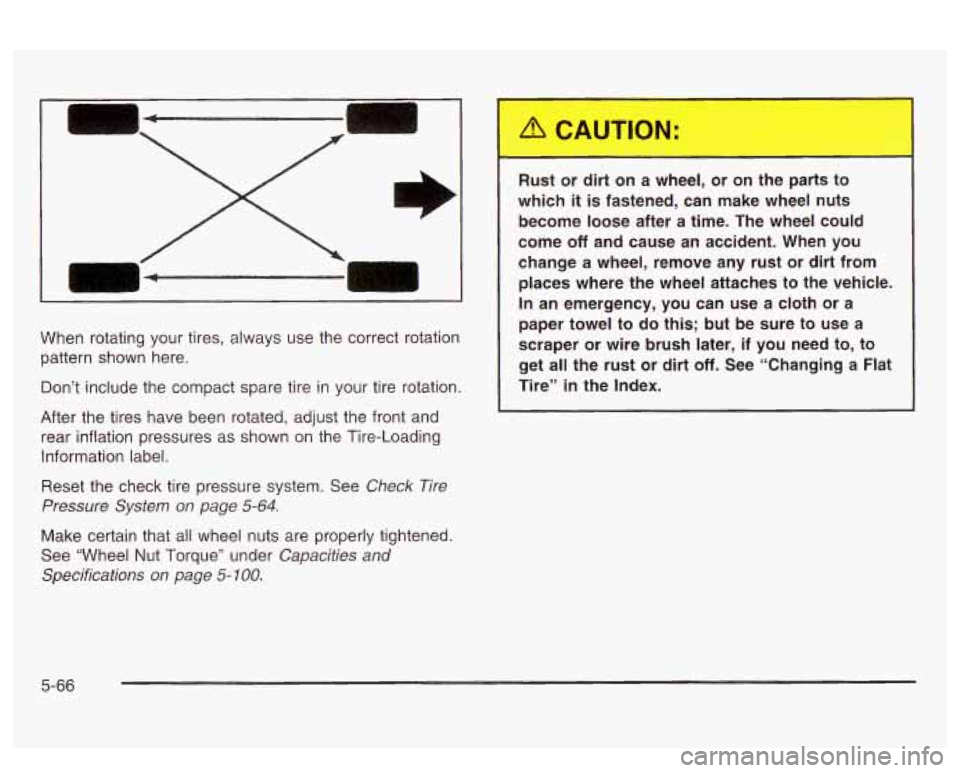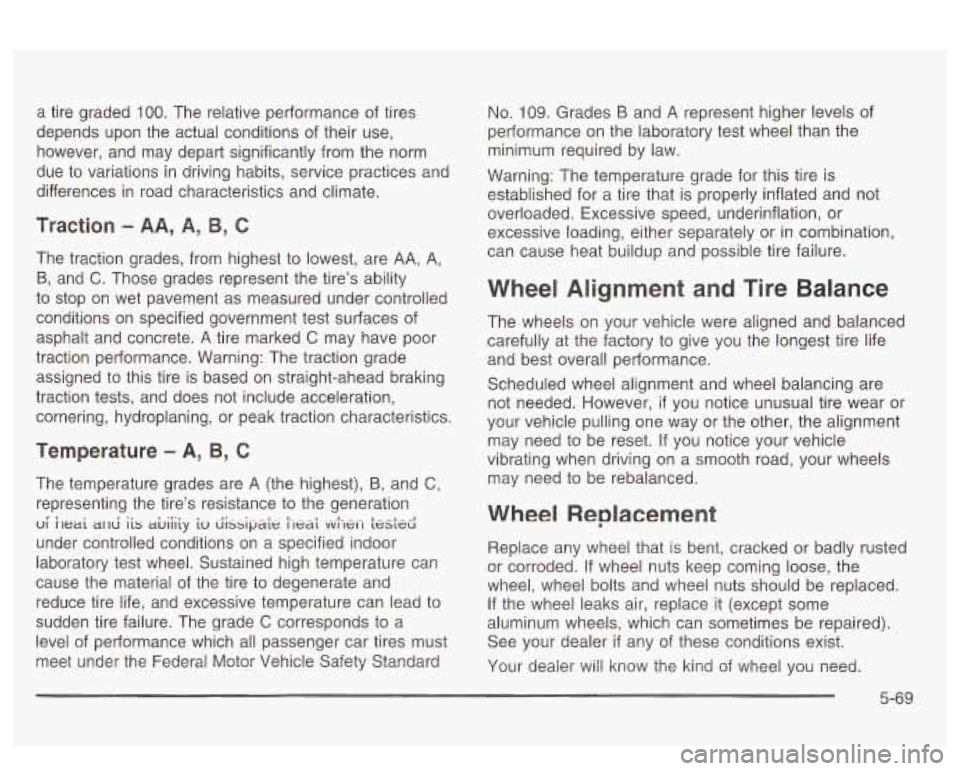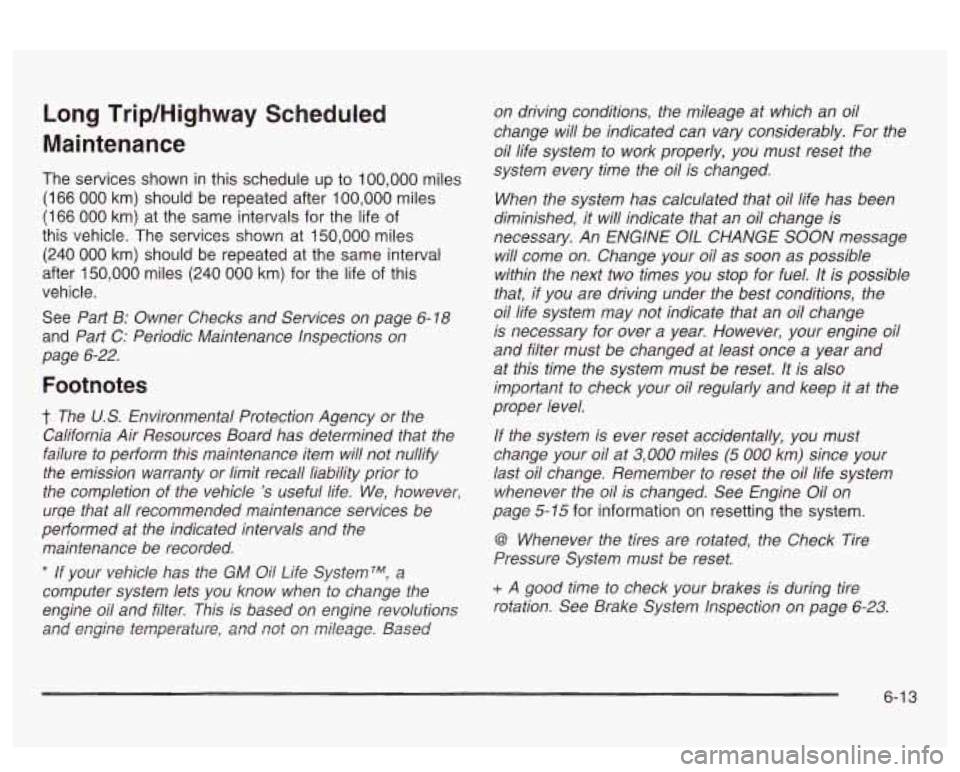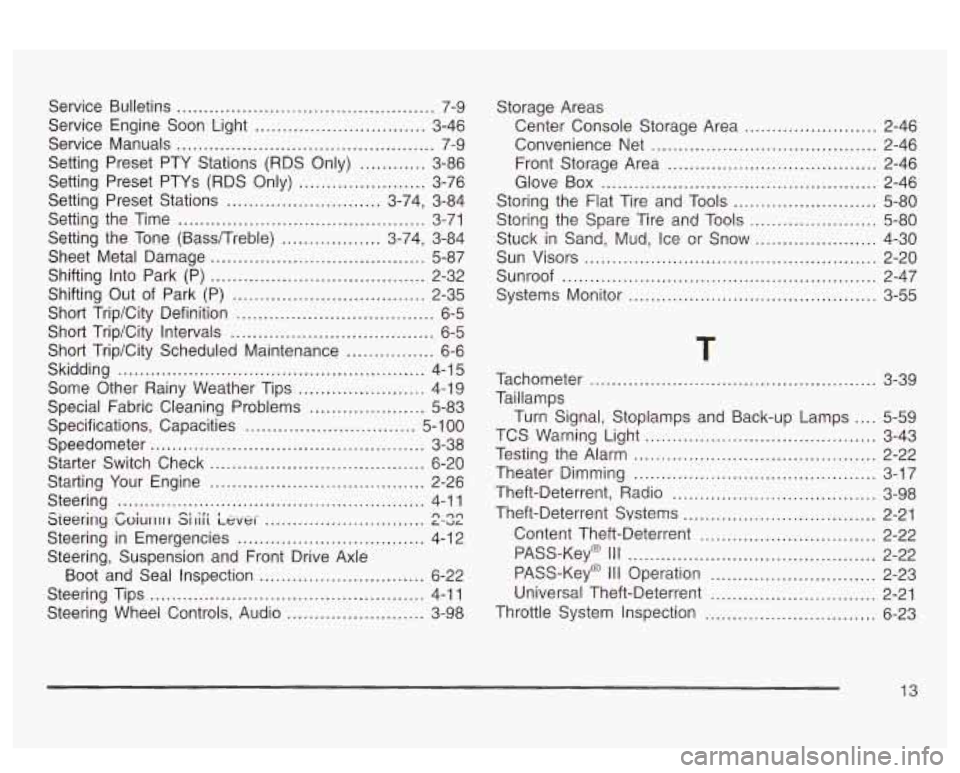2003 PONTIAC BONNEVILLE reset
[x] Cancel search: resetPage 325 of 418

When rotating your tires, always use the correct rotation
pattern shown here.
Don’t include the compact spare tire in your tire rotation.
After the tires have been rotated, adjust the front and
rear inflation pressures as shown on the Tire-Loading
Information label.
Reset the check tire pressure system. See
Check Tire
Pressure System on page
5-64.
Make certain that all wheel nuts are properly tightened.
See “Wheel Nut Torque” under
Capacities and
Specifications on page
5- 100.
Rust or dirt on a wheel, or on the parts to
which
it is fastened, can make wheel nuts
become loose after a time. The wheel could
come
off and cause an accident. When you
change a wheel, remove any rust or dirt from
places where the wheel attaches to
the vehicle.
In an emergency, you can use a cloth or a
paper towel to do this; but be sure to use a
scraper or wire brush later, if you need
to, to
get all the rust or dirt
off. See “Changing a Flat
Tire”
in the Index.
5-66
Page 328 of 418

a tire graded 100. The relative performance of tires
depends upon the actual conditions of their use,
however, and may depart significantly from the norm
due to variations in driving habits, service practices and
differences in road characteristics and climate.
Traction - AA, A, B, C
The traction grades, from highest to lowest, are AA, A,
B, and C. Those grades represent the tire’s ability
to stop on wet pavement as measured under controlled
conditions on specified government test surfaces
of
asphalt and concrete. A tire marked C may have poor
traction performance. Warning: The traction grade
assigned to this tire is based on straight-ahead braking
traction tests, and does not include acceleration,
cornering, hydroplaning, or peak traction characteristics.
Temperature - A, B, C
The temperature grades are A (the highest), B, and C,
representing the tire’s resistance to the generation
under controlled conditions on a specified indoor
laboratory
test wheel. Sustained high temperature can
cause the material of the tire to degenerate and
reduce tire life, and excessive temperature can lead to
sudden tire failure. The grade
C corresponds to a
level of performance which all passenger car tires must
meet under the Federal Motor Vehicle Safety Standard
ui ireai ar~d iis aLiiiiy iu dissip& i-ledf vvi-Iei-1 t&&
No. 109. Grades B and A represent higher levels of
performance on the laboratory test wheel than the
minimum required by law.
Warning: The temperature grade for this tire
is
established for a tire that is properly inflated and not
overloaded. Excessive speed, underinflation, or
excessive loading, either separately or in combination,
can cause heat buildup and possible tire failure.
Wheel Alignment and Tire Balance
The wheels on your vehicle were aligned and balanced
carefully at the factory to give you the longest tire life
and best overall performance.
Scheduled wheel alignment and wheel balancing are
not needed. However,
if you notice unusual tire wear or
your vehicle pulling one way or the other, the alignment
may need to be reset. If you notice your vehicle
vibrating when driving on a smooth road, your wheels
may need
to be rebalanced.
Wheel Replacement
Replace any wheel that is bent, cracked or badly rusted
or corroded.
If wheel nuts keep coming loose, the
wheel, wheel bolts and wheel nuts should be replaced.
If the wheel leaks air, replace it (except some
aluminum wheels, which can sometimes be repaired).
See your dealer
if any of these conditions exist.
Your dealer will know the kind of wheel you need.
5-69
Page 368 of 418

Footnotes
t The U.S. Environmental Protection Agency or the
California Air Resources Board has determined that the
failure to perform this maintenance item will not nullify
the emission warranty or limit recall liability prior to
the completion of the vehicle
's useful life. We, however,
urge that all recommended maintenance services be
performed at the indicated intervals and the
maintenance be recorded.
*If your vehicle has the GM Oil Life SystemTM,
a
computer system lets you know when to change the oil
and filter. This is based on engine revolutions and
engine temperature and not on mileage. Based
on driving conditions, the mileage at which an oil change
will be indicated can vary considerably. For the oii life
system to work properly, you must reset the system
every time the oil is changed.
When the system has calculated that oil life has been
diminished, it will indicate that an oil change is
necessary. An ENGINE
OIL CHANGE SOON message
will come on. Change your oil as soon as possible
within the next two times you stop for fuel. It is possible
that, if you are driving under the best conditions, the
oil life system may not indicate that an oil change
is necessary for over a year. However, your engine oil
and filter must be changed at least once a year and
at this time the system must be reset. It is also
important to check your oil regularly and keep it at the
proper level.
If the system is ever reset accidentally, you must
change your oil at 3,000 miles
(5 000 km) since your
last oil change. Remember to reset the oil life system
whenever the oil is changed. See Engine Oil on
page
5-15 for information on resetting the system.
@ Whenever the tires are rotated, the Check Tire
Pressure §ystem must be reset.
+A good time to check your brakes is during tire
rotation. See Brake System Inspection on page 6-23.
3,000 Miles (5 000 km)
0 Change engine oil and filter (or every 3 months,
whichever occurs first).
An Emission Control Service.
(See footnote
*.)
6,000 Miles (IO 000 km)
u
n U
Change engine oil and filter (or every 3 months,
whichever occurs first).
An Emission Control Service.
(See footnote
*.)
page 5-65 for proper rotation pattern and additional
information.
(See footnote @.) (See footnote +.)
n-4-4- r?-- -I-:-- I 4:-- -...A n-+-+:-- -- I wlalc LII ~a. UGG I 11 G 11 I~JG~LIVII a1 IU I IvLauvII VII
9,000 Miles (15 000 km)
U Change engine oil and filter (or every 3 months,
whichever occurs first).
An Emission Control Service.
(See footnote
*.)
6-7
Page 374 of 418

Long Trip/Highway Scheduled
Maintenance
The services shown in this schedule up to 100,000 miles
(166
000 km) should be repeated after 100,000 miles
(1 66 800 km) at the same intervals for the life of
this vehicle. The services shown at 150,000 miles
(240 000 km) should be repeated at the same interval
after 150,000 miles
(240 000 km) for the life of this
vehicle.
See
Part B: Owner Checks and Services on page 6-18
and Part C: Periodic Maintenance Inspections on
page 6-22.
t The U.S. Environmental Protection Agency or the
California Air Resources Board has determined that the
failure to perform this maintenance item will not nullify
the emission warranty or limit recall liability prior to
the completion of the vehicle
's useful life. We, however,
urqe that all recommended maintenance services be
performed at the indicated intervals and the
maintenance be recorded.
* If your vehicle has the GM Oil Life SystemTM, a
computer system lets you know when to change the
engine oil and filter. This is based on engine revolutions
aiid eiigifie telvpei-atdre, and ncf c:: ml?eage. Based
on driving conditions, the mileage at which an oil
change will be indicated can vary considerably. For the
oil life system to work properly, you must reset the
system every time the oil is changed.
When the system has calculated that oil life has been
diminished, it wil! indicate that an oil change is
necessary. An ENGINE
OIL CHANGE SOON message
will come on. Change your oil as soon as possible
within the next two times you stop for fuel. It is possible
that, if you are driving under the best conditions, the
oil life system may not indicate that an oil change
is necessary for over a year. However, your engine
oil
and filter must be changed at least once a year and
at this time the system must be reset. It is also
important to check your oil regularly and keep it at the
proper level.
If the system is ever reset accidentally, you must
change your oil at
3,000 miles (5 000 km) since your
last oil change. Remember to reset the oil life system
whenever the oil is changed. See Engine Oil on
page
5-75 for information on resetting the system.
@ Whenever the tires are rotated, the Check Tire
Pressure System must be reset.
+ A good time to check your brakes is during tire
rotation. See Brake System Inspection on page
6-23.
6-1 3
Page 410 of 418

Power Accessory Outlets
........................................ 3-23
Door Locks
................................................. 2-1 1
Electrical System
......................................... 5-91
Lumbar Controls
........................................... 1-4
Seat
............................................................ 1-2
Steering Fluid
............................................. 5-40
Windows
.................................................... 2-20
Power Steering
............................................... 4-1 1
Programmable Automatic Door Locks
................. 2-1 3
Programming the HomeLink@ Transmitter
........... 2-43
Questions and Answers About Safety Belts
......... 1-1 1
Radiator Pressure Cap
.................................... 5-29
Radio Messages
..................................... 3.78. 3-88
Radios
.......................................................... 3-71
Care of Your CD Player
.............................. 3-101
Care of Your CDs
...................................... 3-100
Radio with Cassette and CD
......................... 3-82
Setting the Time
.......................................... 3-71
Theft-Deterrent
............................................ 3-98
Trunk-Mounted CD Changer .......................... 3-94
Understanding Reception
.............................. 3-99
-.E V-.,, P-nnnttn Tonn DlqBrnr ual~ VI I UUI WU.J.JCILL’CI mupu . .uJ-. ............... ?-:!x
Radio with CD ............................................ 3-72 RDS Messages
...................................... 3-76,
3-86
Rear Reading Lamps
...................................... 3-19
Rear Safety Belt Comfort Guides
...................... 1-24
Rear Seat Pass Through
................................. 2-46
Rear Underseat Fuse Block
.............................. 5-96
Rear Seat
Passengers, Safety Belts
.................. 1-21
Rear Window Defogger
............................ 3-27, 3-31
Rearview Mirror, Automatic Dimming
.................. 2-38
Rearview Mirrors
............................................. 2-38
Reclining Seatbacks
.......................................... 1-5
Recreational Vehicle Towing
............................. 4-32
Remote Trunk Release
.................................... 2-17
Remote Trunk Release Lockout
........................ 2-17
Removing Fuses
............................................. 5-92
the Spare Tire
............................. ..... 5-75
Removing the Spare Tire and Tools
... ..... 5-74
Wheel Nut Caps
.......................................... 5-74
Replacement Bulbs
......................................... 5-60
Remote
Keyless Entry System
............................ 2-5
Remote Keyless Entry System, Operation
............ 2-6
Removing the Flat Tire and Installing
Removing the Wheel Covers and
Replacing Brake System Parts
.......................... 5-44
Replacing Restraint System Parts After a Crash ..... 1-56
Reporting Safety Defects Canadian Government
................................... 7-8
General Motors
............................................. 7-9
United States Government .............................. 7-8
Reprogramming a Single HomeLink@ Button
....... 2-45
Resetting Defaults
........................................... 2-45
11
Page 412 of 418

Service Bulletins .............................. ..... 7-9
Service Engine Soon Light
............................... 3-46
Service Manuals
............................................... 7-9
Setting Preset PTY Stations (RDS Only)
............ 3-86
Setting Preset PTYs (RDS Only)
....................... 3-76
Setting Preset Stations
............................ 3-74, 3-84
Setting the Tone (Bass/Treble)
.................. 3-74, 3-84
Shifting Into Park (P)
....................................... 2-32
Setting the Time
............................................. 3-71
Sheet Metal Damage
....................................... 5-87
Shifting Out of Park (P)
................................... 2-35
Short Trip/City Definition
.................................... 6-5
Short Trip/City Scheduled Maintenance
................ 6-6
Skidding
........................................................ 4-1 5
Some Other Rainy Weather Tips ....................... 4-19
Special Fabric Cleaning Problems
................. 5-83
Specifications, Capacities
............................ 5-1 00
Speedometer .................................................. 3-38
Starter Switch Check
....................................... 6-20
Steering
........................................................ 4-1 1
Steering in Emergencies .................................. 4-12
Boot and Seal Inspection
.............................. 6-22
Steering Wheel Controls, Audio
......................... 3-98
Short Trip/City
Intervals
..................................... 6-5
Starting Your Engine
....................................... 2-26
Steering
&urrlrl 31111~ ieveI L-JL
Steering, Suspension and Front Drive Axle
Steering Tips
.................................................. 4-1 1
A -I .I. r) r)r) .............................
Storage Areas
Center Console Storage Area
........................ 2-46
Convenience Net
......................................... 2-46
Front Storage Area
...................................... 2-46
Glove Box .............................................. 2-46
Storing the Spare Tire and Tools
....................... 5-80
Sun Visors
..................................................... 2-20
Sunroof
......................................................... 2-47
Systems Monitor
.......................................... 3-55
Storing the Flat Tire
and Tools
...................... 5-80
Stuck in Sand, Mud, Ice or Snow ...................... 4-30
..... 3-39
Tachometer ................................ ~ ~ ~ ~ ~
Taillamps
Turn Signal. Stoplamps and Back-up Lamps
.... 5-59
TCS Warning Light
.......................................... 3-43
Testing the Alarm
............................................ 2-22
Theater Dimming
............................................ 3-17
Theft-Deterrent, Radio
..................................... 3-98
Theft-Deterrent Svstems
................................... 2-21
Content Theft-Deterrent
................................ 2-22
PASS-Key@
Ill ............................................. 2-22
PASS-Key@
Ill Operation .............................. 2-23
Universal Theft-Deterrent
.............................. 2-21
Throttle System Inspection
............................... 6-23
13